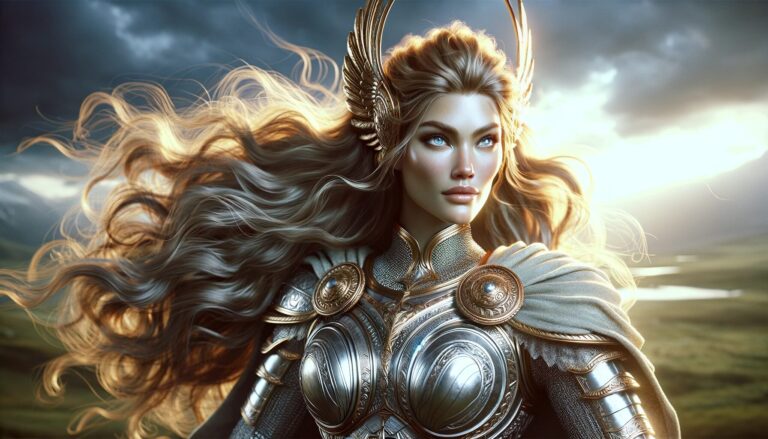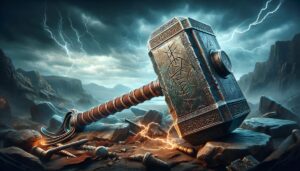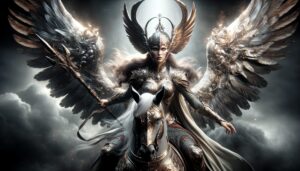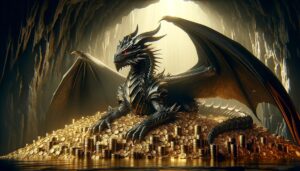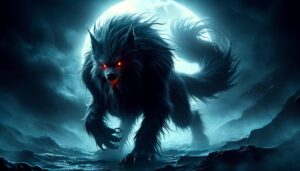Table of Contents
In the rich tapestry of Norse mythology, the figure of Thrud emerges as a fascinating and often overlooked character. Thrud, the daughter of Thor, the mighty god of thunder, and Sif, the golden-haired goddess of fertility, represents not only the physical embodiment of strength but also carries with her a lineage steeped in ancient Norse lore. This mythical being possesses a unique combination of attributes that make her a truly remarkable and distinctive presence within the Norse pantheon.
Origins
Thrud’s story begins with her illustrious parentage. Her father, Thor, is one of the most renowned deities in Norse mythology, known for his incredible strength, his iconic hammer Mjölnir, and his role as the protector of both gods and humans. Her mother, Sif, is celebrated for her beauty, her golden hair, and her association with the earth’s fertility. Thrud’s lineage, therefore, is a powerful blend of might and grace, making her a remarkable figure among the gods and goddesses of the North.
Family Ties
As the daughter of Thor and Sif, Thrud is closely related to several other notable deities in Norse mythology. Her grandfather is Odin, the Allfather and chief of the Aesir, while her uncle is Loki, the trickster god who often finds himself at odds with the Aesir. Thrud’s family connections place her at the heart of the Norse pantheon, with both divine power and complex relationships shaping her character.
Appearance
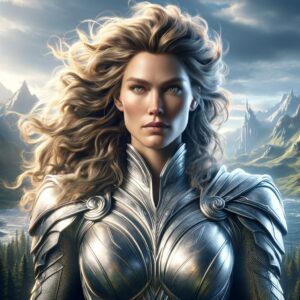
Artists often describe Thrud’s appearance as stunning and imposing. They depict her as a tall and statuesque maiden with long, flowing hair that gleams like burnished gold. Her eyes mirror the color of thunderclouds, reflecting the tempestuous nature of her father. Thrud possesses a robust and muscular physique, a testament to her unparalleled strength. She is often shown wearing armor made of gleaming silver, symbolizing her divine heritage and resilience.
Abilities
Thrud’s abilities are a direct reflection of her parentage. She possesses immense physical strength, rivaled only by her father, Thor. Her might is such that she can easily lift and wield Mjölnir, Thor’s legendary hammer, which is said to be incredibly heavy and can create thunderous strikes when thrown. Her strength also extends to her ability to protect and defend those in need, much like her father’s role as a guardian of gods and humans.
In addition to her physical prowess, Thrud also possesses a deep connection to the elements. She can command storms, summon lightning, and manipulate thunder, further emphasizing her association with her father’s domain. Her abilities make her a formidable force in the realm of Norse mythology, capable of both destruction and protection.
Weakness
While Thrud is a powerful and formidable figure in Norse mythology, she is not without her vulnerabilities. Like all deities, she is subject to the whims of fate and destiny, and her actions can have consequences that affect not only herself but also the world of gods and mortals. Additionally, her intense strength and connection to elemental forces can also make her susceptible to the balance of power within the cosmos, making it essential for her to act wisely and responsibly.
Behavior with Humans
Thrud’s protective nature and her lineage as a defender of both gods and mortals lead to the belief that she would have shown favor and assistance to those who sought her aid, although Norse mythology does not extensively document her interactions with humans. Her association with storms and thunder may have also inspired awe and reverence among ancient Norse people, who often relied on their gods for protection in the harsh northern landscapes.
Symbols

Thrud’s symbols primarily stem from her lineage and her connection to her father, Thor. Artists often depict her with Mjölnir, the thunderous hammer, as a central symbol of her strength and power. They also frequently represent her with golden hair and silver armor, symbolizing her divine heritage and regal presence.
Myths and Stories
Thor’s Battle for Thrud’s Honor
In the myth where Thor seeks Thrud’s hand in marriage to the giant Hrungnir, the story unfolds with Thor’s determination to safeguard his daughter’s honor. Hrungnir, a massive and boastful giant, grew infatuated with Thrud’s beauty and proposed the idea of marriage. Thrud, however, was not interested in this union.
Thor, hearing of Hrungnir’s intentions, was resolute in ensuring Thrud’s happiness and protecting her honor. He confronted Hrungnir and proposed a duel to settle the matter. The two agreed to meet in a designated location for a fierce battle.
As the battle commenced, Thor fought valiantly against the giant Hrungnir, who wielded a massive whetstone as his weapon. In the end, Thor’s mighty hammer, Mjölnir, proved superior, shattering the whetstone and striking Hrungnir dead.
Thor’s unwavering determination and willingness to confront a formidable adversary showcased his deep love for Thrud and his commitment to preserving her honor. This myth underscores the significance of Thrud within the Norse pantheon and the lengths to which Thor would go to protect his beloved daughter.
Stolen Hammer
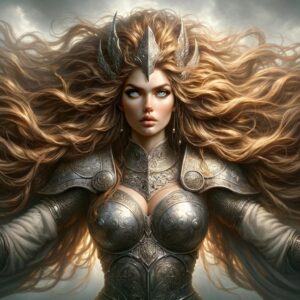
In the myth of Thrud’s role in helping Thor retrieve his stolen hammer, Mjölnir, the story begins with the giant Thrym cunningly stealing Thor’s prized possession. Thrym, a powerful giant, demanded the goddess Freyja as a ransom for the return of the hammer.
Upon hearing of this theft, Thor was enraged and determined to recover Mjölnir. Thrud, his daughter, was equally resolute in aiding her father. Together, they devised a plan to infiltrate Thrym’s stronghold.
In a bold move, Thrud and Thor disguised themselves as Freyja and her handmaiden, respectively, and ventured into the giant’s lair. Thrym, delighted with the apparent success of his scheme, presented the hammer as a gift to “Freyja.”
When Mjölnir was placed before them, Thor and Thrud unveiled their true identities. With the element of surprise on their side, Thor swiftly reclaimed his mighty hammer, and together, father and daughter unleashed their fury upon Thrym and his followers, vanquishing them.
This myth illustrates Thrud’s bravery and unwavering loyalty to her father, solidifying her reputation as a powerful and formidable figure in Norse mythology.
Related Creatures
While there are no direct creatures or beings that share Thrud’s exact abilities and appearance, her association with the elements and her divine lineage link her to other Norse deities, such as her father Thor and her grandfather Odin. These gods share similar attributes of strength and power, as well as a sense of duty to protect the realms of gods and humans.
FAQ
What does the name Thrud mean?
Thrud's name means "strength" or "might" in Old Norse.
What is Thrud's role in Norse mythology?
Thrud's role in Norse mythology is not extensively documented. She is primarily known for her lineage as the daughter of Thor.
Are there specific symbols associated with Thrud?
ymbols associated with Thrud include Mjölnir, Thor's hammer, which represents her strength and power. She is also often depicted with golden hair and silver armor, symbolizing her divine heritage and regal presence.
Did Thrud interact with humans in Norse mythology?
While her interactions with humans are not extensively documented, given her protective nature and lineage as a defender of both gods and mortals, it is believed that she would have shown favor and assistance to those who sought her aid.
